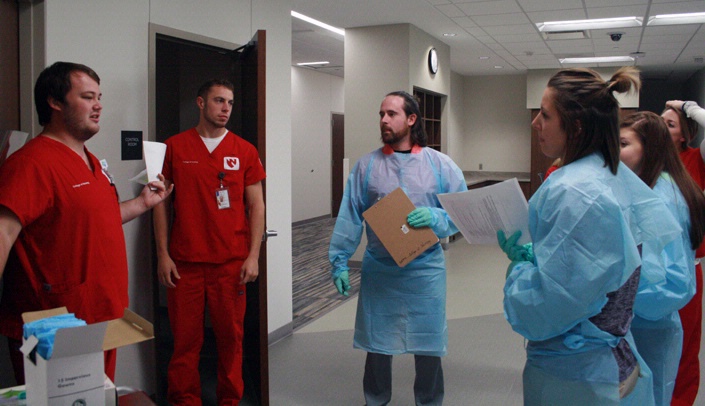Engaging students in interprofessional education (IPE) requires change and effort. One of the challenges is how to build simulation exercises into already demanding and diverse curriculums.
“It’s complex and requires a lot of communication with colleagues,” said Stephanie Burge, instructor at the UNMC College of Nursing Kearney Division, who’s been practicing and teaching for 30 years. “But it’s a good move that will lead to better health care — more patient-centered care as a member of a team based in good problem solving. Hospital safety data from the Institute of Medicine shows safety issues remain huge in hospitals.”
Burge, as a member of an interdisciplinary educational research team, received a $1,000 internal grant to conduct an IPE exercise to measure students’ attitudes about interprofessional education.
Students and faculty at the UNMC College of Nursing Kearney Division and UNMC College of Allied Health Professions in Kearney participated in the recent exercise designed by third-semester nursing students that also involved physical therapy and diagnostic imaging students.
Students together practiced pediatric and geriatric patient hospital scenarios. The exercise prepared many of the students for their first real experience on a hospital floor.
“The first experiences in a hospital can be nerve-wracking,” Burge said. “They find out what it might be like to be in complex health care environments for the first time. Some students have been in a hospital setting, but they can still feel scared and nervous.
“We did a lot of debriefing to see what was learned. They talked about the fact that it’s OK to say ‘I’m uncomfortable in these settings.’ They worked out some angst. And each came away with a much better understanding of what the other discipline’s roles are.”
Kearney radiography student Breanna Eubanks said the exercise was a great experience for everyone. “The experience did a great job of showing how the different departments in the hospital can work together to achieve one main goal, and that is providing the best possible care for the patient. The scenarios they set up both explained situations that we as radiographers could walk in on while the nurses were not available, and we would need to know how to handle them the best we could.”
The team-based faculty effort involved planning and input by Burge and physical therapy faculty Katherine Jones, Tessa Wells and Dawn Venema, as well as Ellie Miller, radiography, and Christina Jackson, Ed.D., simulation and clinical skills specialist.
